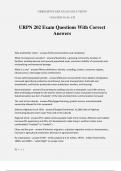©BRIGHTSTARS EXAM SOLUTIONS
11/16/2024 10:16 AM
URPN 202 Exam Questions With Correct
Answers
Why build better cities? - answer✔Interconnectedness and complexity
What must planners consider? - answer✔Aesthetics, a growing community, location of
facilities, avoiding densely and sparsely populated areas, economic stability of community and
minimalizing environmental damage
What is a city? - answer✔Many definitions: density, crowding, clusters, economic engines,
infrastructure, elite (large human settlements)
Forces behind population growth - answer✔Natural increase (birth minus death), immigration,
increased agricultural production (machinery), low cost transportation (railroads and
steamboats), and factory production (mass production, workers, and housing)
Decentralization - answer✔Converting the walking city into a metropolis. Late 19th century.
New technology emerged for the electric street car (electric motor and power transmissions).
Suburbanization was born ("outside" of the city) and electronic communication increased
The rush to the suburbs - answer✔Mortgage financing, greater income, and automobile
ownership allowed for this movement
Defense Highway Act of 1956 - answer✔Dwight Eisenhower. 41,000 miles of highway.
Commuting became even easier from and to the suburbs
Regional trend - answer✔Per capita income (people made more money), affluence and mailbox
increase (life expectancy and SSI), A/C development made living in southern states more
comfortable ("Frostbelt" to "Sunbelt")
Cities and the poor - answer✔Selective migration, suburban migration renters to homeowners,
increase in agricultural production; decrease in agricultural labor
Re-urbanization - answer✔1957 - births peaked at 4.31 million, 1970's - million fewer births,
1980's and 1990's - "white flight" to escape crime
1|Page
, ©BRIGHTSTARS EXAM SOLUTIONS
11/16/2024 10:16 AM
19th century reforms - answer✔Sanitary reforms (water carriage system in England), open
space, and housing (subdivisions)
Why housing reform? - answer✔Elite controlled structure of the cities. Growth and higher land
values disrupted spectator opportunities
Tenement House Committee (1898) - answer✔Tenement Act of 1901. Apartments: 1 bathroom,
courtyard, and open space. In 1920, 40 cities followed suit
Housing responsibility - answer✔Europe: All governments responsibility. Public money used for
housing working poor. Government: landowner, developer, financer.
United States: Housing controlled by the market, government controls the market.
Municipal movements - answer✔City improvement, art (European inspiration: arches, plazas,
circled traffic, fountains), and beautification (union of art, civic improvement, and landscape
design)
Daniel Burnham - answer✔Architect and urban designer. Developed plan for Chicago. Idea born
from City Beautification Era
Zoning - answer✔Dividing land in a municipality into zones (e.g. residential, industrial, and
commercial) in which certain land uses are permitted or prohibited
Defining a region - answer✔Reasonable travel within boundaries, recreation accessible from
city center, aligned with neighboring cities, and considered watersheds and waterways
Depression Era Initiatives - answer✔FHA (Federal Housing Authority), Housing Act of 1949,
Interstate Highway System, National Resource Planning Board, and Tennessee Valley Authority
(TVA-1933)
Post-war planning initiatives - answer✔Expansion of municipal planning, urban renewal (first
major initiative), highway planning, environmental planning, growth control, statewide
planning, economic development planning, and planning for smart growth, public safety, and
natural disasters
How did President Nixon help? - answer✔Made $4 billion improvement of water treatment
facilities, established national air quality standards and stringent guidelines to lower motor
vehicle emissions, launched federally-funded research to reduce automobile pollution, and
made legislation o end the dumping of wastes into the Great Lakes
2|Page




